
One of the most beautiful show cars of the 1950s was the Norseman, designed by Chrysler in America and built by Carrozzeria Ghia in Italy. It was a revolutionary concept car – the culmination of 50,000 man hours of engineering work, $200,000 of treasure spent, and the creative genius of many people lead by Virgil Exner, Director of Styling. But no one ever saw the finished car except the people who actually built it.
Virgil Exner was born in Ann Arbor, Michigan in 1909 to parents of Scottish and Norwegian heritage who could not support him and so put him up for adoption at birth. Iva and George Exner adopted him and named him Virgil Max Exner. They were loving parents, and George instilled in the boy a sense of creativity and the love of making things. Virgil liked to draw and sculpt, and he pursued artistic interests throughout his education until the Great Depression forced him to leave college. He found menial work at a local branch office of a large Detroit advertising agency.
Exner was an enthusiastic young man fascinated by cars and displayed his personal automotive design sketches in his cubicle at work. Another company employee from the home office in Detroit visited Exner’s office and happened to see the sketches. The fellow had close ties with the automakers and encouraged Exner to apply for a design position with one of them. This was in the early days of the formation of design studios at the automakers.
Upon hearing of General Motors hiring designers, Exner took the plunge In 1933 and submitted a portfolio of his designs to Harley Earl. He was hired, and soon became at 26 years of age the youngest person to ever head a design studio – the Pontiac studio. It was a great start to a great career.
During succeeding years, Exner left GM and held positions with Raymond Loewy, Studebaker, and finally became the first Vice President of Styling at Chrysler. He managed teams of people that included many of the great design talents of the time. Exner moved automotive design forward from what he termed “upside down bathtubs” to some of the most imaginative and iconic car designs of the 1950s – or ever! But his show cars made his production work pale by comparison.
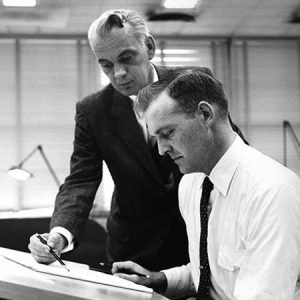
Virgil Exner and Cliff Voss refining a design.
Carrozzeria Ghia of Turin, Italy had approached the Big Three in 1949 to offer their custom coachbuilding and prototyping services as a way to give form to design and engineering ideas for production cars. Ghia constructed coachwork bodies for prominent European automobile companies and delivered excellent quality and quick production at a cost far less than domestic American coachbuilders. Ghia was capable of building prototypes of anything that could be imagined. Virgil Exner saw the perfect opportunity to realize his advanced ideas in a series of Chrysler show cars. Never mind that the builder was located in Europe; shipping by high speed ocean liners was commonplace!
One of the earliest show cars to be built by Ghia for Chrysler was the Norseman. It is believed that the name was chosen as a tribute to Exner’s Norwegian ancestry. Built in 1956 for the1957 car show circuit, it was wholly conceived in the newly formed Chrysler design studios. The car’s concepts launched the design direction Chrysler products would take until downsizing began in the 1960s. Exner’s later production designs are sometimes criticized for being overly complicated, flamboyant, and impractical. However, the Norseman was a clean, stylish jaw dropper. It was an inspired beginning.
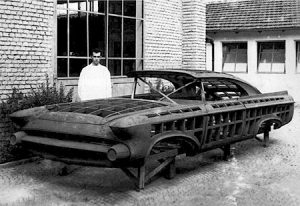
The Norseman body buck at Carrozzeria Ghia.
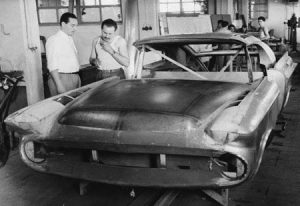
The Norseman takes shape.
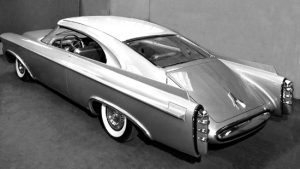
Early Jet-Age styling on the Norseman.
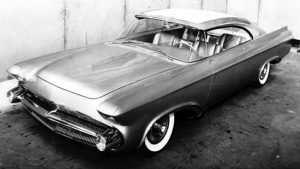
The Norseman’s cantilevered roof.
The first thing most people notice is the Norseman had a cantilevered roof with apparently no “A” pillars supporting its front edge. In actuality, there was a special quarter inch diameter steel rod at each front corner of the windshield that held the roof in tension. Specially developed high strength glass gave the roof additional support. The lack of “A” pillars combined with a wraparound windshield to give the driver unrestricted sightlines to the front and sides of the vehicle. In effect, the Norseman’s roof appeared to float above the body of the car. But that wasn’t all that made the roof special. The huge backlight could be retracted into the roof to fully open the rear of the passenger compartment to the air!
The Norseman included many other advanced design ideas. It was an early expression of jet-age styling. The fastback design ended with two large chrome bumpers reminiscent of rocket fire emerging from what looked like jet engine nacelles. To enhance the illusion, three tail lights were inset into each bumper. The headlights were hidden, allowing the front end to be simplified and streamlined. The doors were opened with push buttons, eliminating door handles and further smoothing the body. The Norseman looked like it was going at supersonic speeds even when it was standing still.
The Norseman was a fully functional automobile as well. Inside, swiveling bucket seats held the passengers who had their own consoles, seat belts, and lighting. The suspension was identical to the new 1957 production models. It had a 331 cubic inch 235 horsepower hemi V8 engine that drove the rear wheels through a 2 speed automatic transmission – a push button PowerFlite. The frame and body were custom, but the powertrain was all Chrysler!
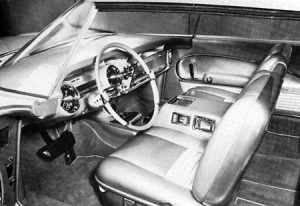
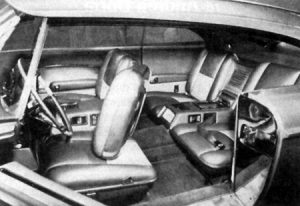
This all came together in what is perhaps one of the most beautiful show car designs of the 1950s. It was packed and loaded into a special crate for shipment to the United States and then to the auto shows. The best method of shipping special cargo at that time was aboard passenger ocean liners. They were fast, they were safe, and they were reliable. Chrysler would use only the best one to transport its latest show car, and so the Norseman was loaded aboard the flagship of the Italian fleet, the Andrea Doria.
The ship almost made it to America. On July 25, 1956, the Swedish-American liner Stockholm was heading outbound from New York through a very thick fog enroute to Goteborg, Sweden with 534 passengers and 215 crew members aboard. The Andrea Doria was heading inbound towards New York with 1,134 passengers and 572 crew members aboard. Both ships were aware of each other. Both ships were proceeding cautiously but confident in the ability of their radars to let them see through the fog. Both crews apparently misread their radars, however, and the two ships were closer than either crew thought. Much closer. The two ships collided, with the bow of the Stockholm cutting a slice out of the Andrea Doria, opening up her watertight compartments to the sea. The Stockholm remained afloat, but after taking on water for 11 hours, the Andrea Doria sank to the inky black, cold bottom, and the Norseman went with her.
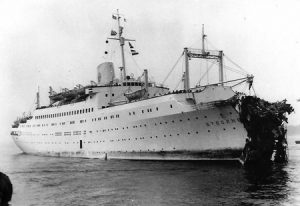
The Stockholm.
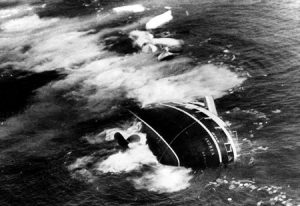
The Andrea Doria goes to the bottom.
Epilogue
Tragically, 46 passengers and crew on the Andrea Doria perished in the collision, and five lives were lost on the Stockholm. A husband watched his wife get swept into the sea by the bow of the Stockholm and disappear. A 14 year old girl named Linda Morgan was asleep on the Andrea Doria and was knocked out of her bed and onto the Stockholm’s wrecked bow. Miraculously, she survived. The living and dead were evacuated by lifeboats from other ships answering the distress calls.
The people who had spent so much energy creating the Norseman never got to see the car. No one is even sure what color Ghia painted it. They took only a few photographs of it before sealing it in its crate forever, and those photos were in black and white. However, for the designers and builders there was a bright spot. They had the thrill of creating something really new and the satisfaction of bringing it into reality. For Chrysler there was a bright spot, too. The Norseman was insured.
Grundy Insurance can protect our customers’ cars during shipment overseas and while abroad for tours, Concours, and other car events. Contact us for additional details at 866-338-4006.
William Hoffer, Director of Marketing, Grundy Insurance








Wondering if there was ever any interest in a recon mission to search for the car in the wreckage?
Hi Randall,
Diving the wreck of the Andrea Doria is extremely difficult and is regarded by the scuba diving community as the “Mount Everest of wreck diving”. It is approximately 250 feet down in cold, black waters with treacherous currents. It is shrouded with fishing nets and lines that can entangle a diver. The wreck is also collapsing. Tragically, at least 16 people have died diving the Andrea Doria. But there is at least one private company that leads chartered dives on the wreck that fascinates people so.
It is likely that the Norseman dissolved into nothing in as little as 2 years after the sinking. To our knowledge, no one ever tried to enter hold # 2 because it is located in the interior of the hull and regarded as impossible to reach by a diver. It is surely better to simply imagine what might be there than to read about another life lost trying to see.